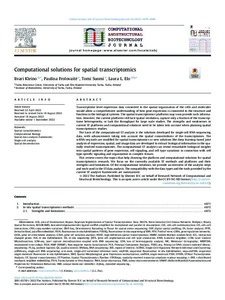Computational solutions for spatial transcriptomics
Kleino Iivari; Frolovaitė Paulina; Suomi Tomi; Elo Laura L
https://urn.fi/URN:NBN:fi-fe2022102463062
Tiivistelmä
Transcriptome level expression data connected to the spatial organization of the cells and molecules would allow a comprehensive understanding of how gene expression is connected to the structure and function in the biological systems. The spatial transcriptomics platforms may soon provide such information. However, the current platforms still lack spatial resolution, capture only a fraction of the transcriptome heterogeneity, or lack the throughput for large scale studies. The strengths and weaknesses in current ST platforms and computational solutions need to be taken into account when planning spatial transcriptomics studies.
The basis of the computational ST analysis is the solutions developed for single-cell RNA-sequencing data, with advancements taking into account the spatial connectedness of the transcriptomes. The scRNA-seq tools are modified for spatial transcriptomics or new solutions like deep learning-based joint analysis of expression, spatial, and image data are developed to extract biological information in the spatially resolved transcriptomes. The computational ST analysis can reveal remarkable biological insights into spatial patterns of gene expression, cell signaling, and cell type variations in connection with cell type-specific signaling and organization in complex tissues.
This review covers the topics that help choosing the platform and computational solutions for spatial transcriptomics research. We focus on the currently available ST methods and platforms and their strengths and limitations. Of the computational solutions, we provide an overview of the analysis steps and tools used in the ST data analysis. The compatibility with the data types and the tools provided by the current ST analysis frameworks are summarized.
Kokoelmat
- Rinnakkaistallenteet [27094]
